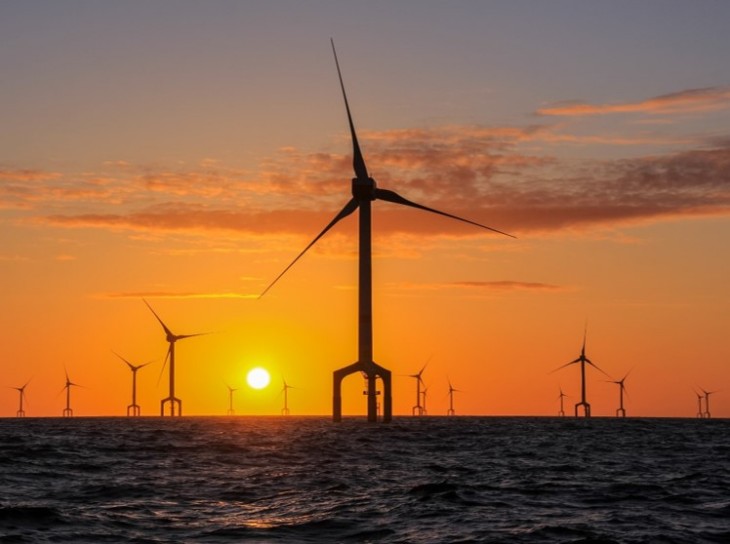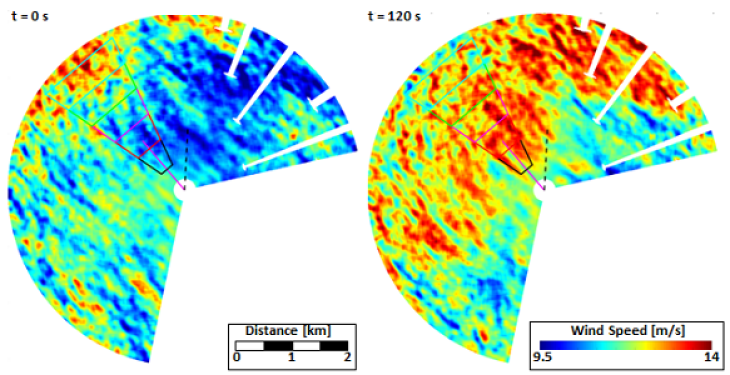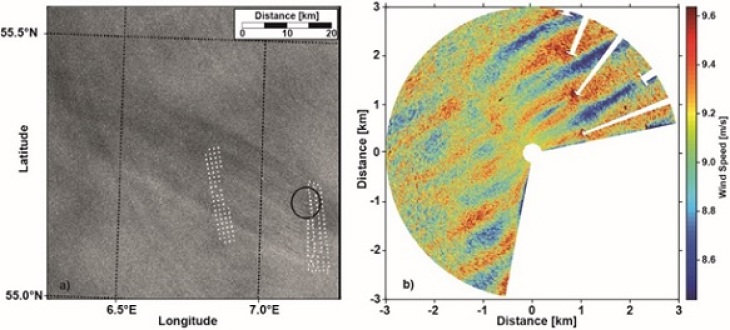Wind Farms

Wind farm in the North Sea. image: Matthias Krüger / Hereon
During the last decade, the North Sea has experienced a considerable increase in offshore wind farm development. At the end of 2020, the capacity in the North Sea has reached approximatily 25 GW which are generated by over 5400 individual piles.
This rapid transformation of the southern North Sea into an energy seascape may compromise environmental development goals stipulated by national and international legislation and bears conflict potential with other natural resources, such as fisheries.
Therefore the Helmholtz-Zentrum Hereon examines the physical, biogeochemical and ecosystem effects of offshore wind farms as well as social and planning aspects.
Within the Institute of Coastal Ocean Dynamics we are concentrating on the physical properties related to offshore wind farms.
Ocean Turbulence

Turbulent velocity field in the wake of a cylindrical offshore wind farm structure. This is a snapshot from a Large Eddy Simulation looking from above on the water surface, with the current moving from left to right past the circular structure. Blue indicates a strong current, and red a weak current. image: Jeff Carpenter / Hereon)
Ocean turbulence is caused by the interaction of tidal currents and the Offshore Wind Farm (OWF) structures. It provides an additional mixing potential for the seasonal stratification that forms throughout large areas of the German Exclusive Economic Zone (EEZ). In this way, it is possible for large-scale OWF constructions to have a significant impact on North Sea stratification.
Current work is focused on understanding and quantifying the mixing process of OWF foundations using Large Eddy Simulations and in situ measurements. Initial results suggest that the low thermocline turbulence is expected to be enhanced by OWFs and that large farms could have a significant impact on the stratification.
Publications:
Schultze, L.K.P., Merckelbach, L., & Carpenter, J.R. (2017): Turbulence and Mixing in a Shallow Stratified Shelf Sea from Underwater Gliders. Journal of Geophysical Research -- Oceans, 122, doi:10.1002/2017JC012872
Floeter, J., Beusekom, J.E.E. van, Auch, D., Callies, U., Carpenter, J.R., et al. (2017): Pelagic Effects of Offshore Wind Farm Foundations in the Stratified North Sea. Progress in Oceanography, 156, 154–173, doi:10.1016/j.pocean.2017.07.003
Carpenter, J.R., Merckelbach, L., Callies, U., Clark, S., Gaslikova, L., & Baschek, B. (2016): Potential Impacts of Offshore Wind Farms on North Sea Stratification. PLoS ONE, 11(8), e0160830, doi:10.1371/journal.pone.0160830
Schultze, L.K.P., Merckelbach, L., Horstmann, J., Raasch, S. & Carpenter, J.R. (2020): Increased mixing and turbulence in the wake of offshore wind farm foundations. Journal of Geophysical Research – Oceans, 125, doi: 10.1029/2019JC015858.
Wind gusts

Surface radar retrieved wind fields (120 s apart in time) of a wind gust propagating towards the offshore platform Fino-3 in the German Bight. image: Radar Hydrography / Hereon
For an improved predictive control of offshore wind farms, Hereon has developed a short-term (30 to 60 s) wind speed and gust prediction system. Wind fields are retrieved from marine radar image sequences to identify wind gusts and estimate their size and propagation speed and direction.
Windwakes

Sentinel-1 SAR image showing the large-scale wind wake of offshore wind farm DanTysk (left) and a wind field retrieved from Hereon’s marine radar in the area marked by the circle on the SAR image. image: Radar Hydrography / Hereon
Wind turbines extract momentum from the wind field but at the same time add turbulence. The resulting wakes are visible in radar images and show the dependencies of the wakes on the wind mill's size and height as well as farm size; the wakes scale up to hundred kilometers and more.
By comparison of synthetic aperture radar (SAR) data, acquired by the SENTINEL-1 and TerraSAR-X satellites, with profile measurements taken at the FINO-1 research platform, it was shown that the wake length increases with atmospheric stability.
Additional studies were performed to analyze the interaction of wakes originating from different wind parks in the German Bight. Furthermore effects of single wind turbines on wind and friction velocity are observed with high spatial and temporal resolution using Hereon's marine radars, which show strong wind speed shear zones across the individual wakes.
Publications:
Vicen-Bueno, R., Horstmann, J., Terril, E., Paolo, T. de, & Dannenberg, J. (2013): Real-Time Ocean Wind Vector Retrieval from Marine Radar Image Sequences Acquired at Grazing Angle. J. Atmos. Oceanic Technol., Vol. 30, p. 127–139, doi:10.1175/JTECH-D-12-00027.1
Djath, B., Schulz-Stellenfleth, J., & Cañadillas, B. (2018): Impact of atmospheric stability on X-band and C-band synthetic aperture radar imagery of offshore windpark wakes. Journal of Renewable and Sustainable Energy, Volume 10, Issue 4, doi:10.1063/1.5020437
